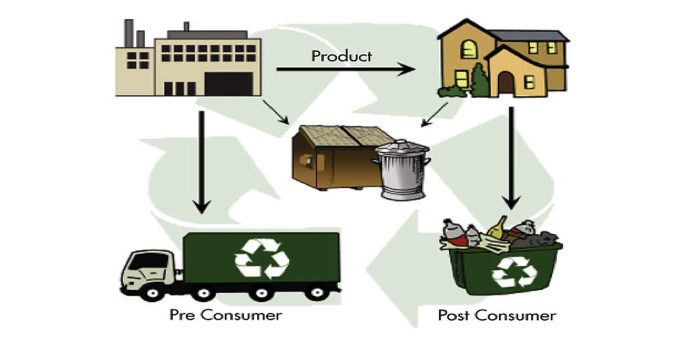Buying products with recycled content fosters the diversion and recycling of materials from the solid waste stream and promotes the use of these materials in the manufacture of new products. It creates domestic markets for materials collected and recycled through local recycling programs, strengthening local economies and the United States’ recycling system.
Pre-Consumer vs. Post-Consumer
If a package or item contains recycled content, it means it was made, at least in part, from recycled material. Recycled material can be derived from two sources: pre-consumer or post-consumer.
Pre-consumer material is an additional source of recycled content. Essentially, it is the waste generated from the original manufacturing process that is used again in the same material. For example, when making soda cans, a roll of aluminum is cut into round pieces that are then molded into their traditional shape. Scraps from the cutting process are then melted down, rolled again, and the process continues.
Post-consumer recycled material refers to everything we toss into the recycling cart, such as empty plastic bottles or aluminum cans. These materials are collected by local recycling programs and shipped to recycling facilities where they are sorted into bales by material type. The bales are then purchased and processed into new items or packaging. Brands then purchase the new product/packaging material and customize it with their company’s label so it can be purchased by consumers again.
Both pre-consumer and post-consumer recycling are valuable and play an important role in promoting sustainable practices. Using recycled content has many significant environmental advantages such as reducing energy consumption and extraction of finite resources. Further, in certain cases using recycled content can be advantageous from a cost perspective. With increasing frequency and volume, brands are publicly announcing specific goals for sourcing a certain percentage of their paper and/or plastic from recycled material. Now, more than ever, consumers are seeing many of their favorite brands advertising products made with recycled content.
Post-consumer recycled material is preferable because it’s less likely to end up in a landfill than pre-consumer waste given that manufacturers have long been keen on reusing and repurposing scrap materials in various ways. Some would say that pre-consumer recycled content isn’t even truly recycled at all because the waste involved isn’t even truly waste. The environmental stakes are higher with post-consumer waste because if not properly recycled, the chance that it would end up going to waste is greater.
This webinar highlights the role of procurement in stimulating recycling markets, explains the government’s “buy-recycled” program and helps facilitate public review of the program.
Sources:
Recycled Content vs Recyclability; Sustainable Packaging Coalition
Recycled Content (ReCon) Tool; EPA
Newton Sustainable Materials Management Green Cart Chronicles, November 2020



Recently on Twitter